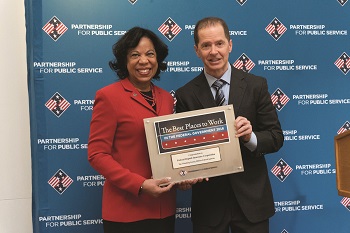Effective Management of Strategic Resources
The FDIC recognizes that it must effectively manage its human, financial, and technological resources to successfully carry out its mission and meet the performance goals and targets set forth in its annual performance plan. The FDIC must align these strategic resources with its mission and goals and deploy them where they are most needed to enhance its operational effectiveness and minimize potential financial risks to the DIF. Following are the FDIC’s major accomplishments in improving operational efficiency and effectiveness during 2018.
Human Capital Management
The FDIC’s human capital management programs are designed to attract, train, develop, reward, and retain a highly skilled, diverse, and results-oriented workforce. In 2018, the FDIC workforce planning initiatives emphasized the need to plan for employees to fulfill current and future capability and leadership needs. This focus ensures that the FDIC has a workforce positioned to meet today’s core responsibilities and prepared to fulfill its mission in the years ahead.
Strategic Workforce Planning and Readiness
During 2018, the FDIC continued to develop and implement integrated workforce development strategies to address workforce challenges and opportunities. The effort is focused on four broad objectives:
- Attract and develop talented employees across the agency;
- Enhance the capabilities of employees through training and diverse work experiences;
- Encourage employees to engage in active career development planning and seek leadership roles in the FDIC; and
- Build on and strengthen the FDIC’s operations to support these efforts.
In 2018, the FDIC continued to develop the programs and processes to help meet its long-term workforce and leadership needs. The FDIC is committed to building and growing its talent pipeline to ensure succession challenges are met. To that end, the agency expanded its succession planning efforts in 2018 to include a survey of 4,000 non-supervisory employees occupying positions that could feed into the agency’s longer-term pipeline for management positions. The survey was designed to identify the population’s aspiration to higher-level and management roles, their perceptions of readiness for these opportunities, and actions they have taken to prepare themselves.
Nearly two-thirds of mid-level non-supervisor respondents reported that they were interested in seeking higher-level positions at the FDIC. Of these, more than three-quarters believe they have the talents and skills for higher-level positions and plan to apply for promotions and details over the next five years, demonstrating their ongoing interest in career development. The FDIC also learned that less than half of respondents have discussed their career interests and plans with a manager.
As a result of the survey findings, the FDIC plans to further develop the longer-term pipeline of the FDIC’s aspiring leadership pool. Plans include supervisory training in succession management techniques, developing resources to support career planning discussions between managers and staff, and promoting emerging manager coaching through FDIC’s Career Management Program.
The FDIC’s strategic workforce planning initiatives require a long-term and sustained focus to identify future workforce and leadership needs, assess current capabilities, support aspiration to management and leadership roles, and develop and source the talent to meet emerging workforce needs. Through further development of its human capital strategies, the FDIC will work to ensure that the future FDIC workforce is as prepared, capable, and dedicated as the one it has today.
Corporate Employee Program
The FDIC’s Corporate Employee Program (CEP) sponsors the development of newly hired Financial Institution Specialists (FIS) in entry-level positions. During the first-year rotation within the program, FIS gain experience and knowledge in the core business of the FDIC, including DCP, RMS, DRR, and DIR. At the conclusion of the rotation period, FIS are placed within RMS or DCP, where they continue their career path to become commissioned examiners.
The CEP is an essential part of the FDIC’s ability to provide highly trained staff for its core occupational series, and ultimately for its future senior technical and leadership positions. Nearly 500 individuals are active in this multi-discipline program. Since the CEP’s inception in 2005, more than 980 employees have become commissioned examiners after successfully completing the program’s requirements.
The FDIC continues to sponsor the Financial Management Scholars Program (FMSP), an additional hiring source for the CEP. Participants in the FMSP complete an internship with the FDIC the summer following the conclusion of their junior year in college. The program serves as an additional avenue to recruit talent.
Employee Learning and Development
The FDIC is committed to training and developing its employees throughout their careers to enhance technical proficiency and leadership capacity, supporting career progression and succession management. The FDIC is focused on developing and implementing comprehensive curricula for its business lines to prepare employees to meet new challenges. Such training, which includes both classroom and online instruction for maximum flexibility, is a critical part of workforce and succession planning as more experienced employees become eligible for retirement.
The FDIC also offers a comprehensive leadership development program that combines core courses, electives, and other enrichment opportunities to develop employees at all levels. From new employees to new executives, the FDIC provides employees with targeted leadership development opportunities that align with key leadership competencies. In addition to a broad array of internally developed and administered courses, the FDIC also provides its employees with funds and/or time to participate in external training to support their career development.
Employee Engagement
The FDIC continually evaluates its human capital programs and strategies to ensure that it remains an employer of choice, and that all of its employees are fully engaged and aligned with the mission. The FDIC uses the Federal Employee Viewpoint Survey mandated by Congress to solicit information from employees and takes an agency-wide approach to address key issues identified in the survey. The FDIC continues to rank near the top in all categories of the Partnership for Public Service Best Places to Work in the Federal Government® list for mid-size federal agencies. Effective leadership is the primary factor driving employee satisfaction and commitment in the federal workplace, according to a report by the Partnership for Public Service.

Photo credit: Partnership for Public Service
Deputy to the Chairman and Chief Operating Officer and Director of the Division of Administration Arleas Upton Kea receives the award for Best Places to Work in the Federal Government for mid-sized federal agencies from Max Stier, President and CEO of Partnership for Public Service.
The FDIC engages employees through formal mechanisms such as the Workplace Excellence program, Chairman’s Diversity Advisory Councils, and Employee Resource Groups; and informally through working groups, team discussions, and daily employee-supervisor interactions. Employee engagement plays an important role in empowering employees and helps maintain, enhance, and institutionalize a positive workplace environment.

Employee Resource Groups bring people together.

